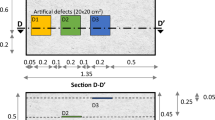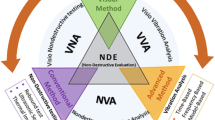Abstract
Acoustic emission (AE) localization is an important method to detect defects in bearing of rotatory machine for faults maintenance. However, only the faults near the sensor array can be detected due to severe attenuation in the recorded AE signals. Therefore, we propose a highly reliable new Iterative near-field Coherent subspace method (IN-CSM) for multiple rub-impact faults localization. The proposed approach contains four improved processes: Modal plate wave theory (MPWT) analysis for the multi-modes decomposition and group velocity revision; Discrete wavelet transform (DWT) for the useful narrow band extraction; Near field Multiple signal classification (N-MUSIC) method for the preliminary position estimations; the IN-CSM algorithm for the multiple coherent sources separation and the precise localizations. The simulations based on N-MUSIC and IN-CSM methods were compared by rubbing teston the test rig of rotation machinery. The results indicate that the proposed method can effectively locate multiple coherent rubbing faults at once. Thus, it is an effective analysis tool for rub-impact fault detection.
Similar content being viewed by others
References
Z. A. Halim, N. Jamaludin, S. Junaidi and S. Y. S. Yahya, Vibration impact acoustic emission technique for identification and analysis of defects in carbon steel tubes: Part A Statistical analysis, J. of Mechanical Science and Technology, 29 (4) (2015) 1547–1557.
Y. S. An, D. S. Gu and J. M. Lee, Development and application of intensified envelope analysis for the condition monitoring system using acoustic emission signal, J. of Mechanical Science and Technology, 28 (2014) 4431–4439.
T. Y. Wu, C. H. Lai and D. C. Liu, Defect diagnostics of roller bearing using instantaneous frequency normalization under fluctuant rotating speed, J. of Mechanical Science and Technology, 30 (3) (2016) 1037–1048.
S.-J. Yoon, D. Chen, S.-W. Han, N.-S. Choi and K. Arakawa, AE analysis of delamination crack propagation in carbon fiber-reinforced polymer materials, J. of Mechanical Science and Technology, 29 (1) (2015) 17–21.
Y. Oh and H. Y. Hong, Vibration analysis of rotating cantilever beams orienting inward, J. of Mechanical Science and Technology, 30 (9) (2016) 4177–4184.
P. Kundu, N. K. Kishore and A. K. Sinha, A non-iterative partial discharge source location method for transformers employing acoustic emission techniques, Applied Acoustics, 70 (11) (2009) 1378–1383.
M. Ahadi and M. S. Bakhtiar, Leak detection in waterfilled plastic pipes through the application of tuned wavelet transforms to acoustic emission signals, Applied Acoustics, 71 (7) (2010) 634–639.
Y. W. Shin, M. S. Kim and S. K. Lee, Identification of acoustic wave propagation in a duct line and its application to detection of impact source location based on signal processing, J. of Mechanical Science and Technology, 24 (12) (2010) 2401–2411.
M. R. Gorman, R. Michael and H. P. William, AE source orientation by plate wave analysis, J. Acoust Emiss., 9 (1991) 283–288.
S. Mohd, K. M. Holford and R. Pullin, Continuous wavelet transform analysis and modal location analysis acoustic emission source location for nuclear piping crack growth monitoring, International Nuclear Science, Technology and Engineering Conference, 1584 (2014) 61–68.
G. C. McLaskey, S. D. G. Glaser and U. Christian, Beamforming array techniques for acoustic emission monitoring of large concrete structures, J. of Sound and Vibration, 329 (12) (2010) 2384–2394.
T. He, D. Xiao, Q. Pan, X. Liu and Y. Shan, Analysis on accuracy improvement of rotor–stator rubbing localization based on acoustic emission beamforming method, Ultrasonics, 54 (1) (2014) 318–329.
A. D. Deng, H. Tong, J. Cao, H. Qin and X. Yan, Study on location algorithms of beamforming based on MVDR, Applied Mathematics & Information Sciences, 7 (6) (2013) 2455–2466.
Y. Zhong, S. Yuan and L. Qiu, Multiple fault detection on aircraft composite structures using near-field MUSIC algorithm, Sensors and Actuators A: Physical, 214 (2014) 234–244.
R. Schmidt, Multiple emitter location and signal parameter estimation, IEEE Transactions on Antennas and Propagation, 34 (3) (1986) 276–280.
Y. B. Fan, F. S. Gu and A. Ball, Acoustic emission monitoring of mechanical seals using MUSIC algorithm based on higher order statistics, Key Engineering Materials, 413 (2009) 811–816.
B. Li, P. Duan, L. Qiang and J. Zhuo, A graphical edge method to solve dispersion equation of lamb waves, Proceedings of the First Symposium on Aviation Maintenance and Management-Volume I, Springer Berlin Heidelberg (2014) 471–479.
F. Tomasz, L. Stefan, F. Tomasz and W. Andrzej, Condition monitoring of engine timing system by using wavelet packet decomposition of an acoustic signal, J. of Mechanical Science and Technology, 28 (2014) 1663–1671.
F. Hemmati, M. Alqaradawi and M. S. Gadala, Rolling element bearing fault diagnostics using acoustic emission technique and advanced signal processing, Proceedings of the Institution of Mechanical Engineers, Part J: J. of Engineering Tribology (2015) 1350650115591233.
R. J. Mailloux, Phased array antenna handbook, Boston, MA: Artech House, 2 (2005).
H. Wang and M. Kaveh, Coherent signal-subspace processing for the detection and estimation of angles of arrival of multiple wide-band sources, IEEE Transactions on Acoustics, Speech, and Signal Processing, 33 (4) (1985) 823–831.
F. Wang, X. Cui and M. Lu, A new iterative coherent subspace method for wideband direction finding, 2015 IEEE Radar Conference (RadarCon), IEEE (2015) 0405–0410.
Author information
Authors and Affiliations
Corresponding author
Additional information
Recommended by Associate Editor Cheolung Cheong
Jing Li received the B.A. (2005) from Hebei University of Engineering, the M.S. (2008) from China University of Mining & Technology. She is currently pursuing the Ph.D. at Southeast University. Her main research interests include signal processing, sensor array technology as applied to rotating machinery fault diagnosis application using AE technique.
Aidong Deng received his B.E. (1991) in Industrial Electric Automation from Harbin Shipbuilding Engineering Institute, the M.S. (1994), and the Ph.D. (2008), both from Southeast University. Currently, he is a Professor with the National Engineering Research Center of Turbo-generator Vibration of School of Energy & Environment, Southeast University, Nanjing, China. Recently he has been working on acoustic emission technology for rotating machinery fault diagnosis application.
Yong Yang received his B.E. (2004) from Hebei University of Engineering in 2004 and the M.S. (2009) from China University of Mining and Technology. He is currently pursuing the Ph.D. at China University of Mining and Technology. His main research interests include signal processing and fault analyses as applied to AE signal recognition applications.
Xinmin Cheng received his B.E. (1990) in automation from Zhejiang Sci-tech University, the M.S. (2004) from Southeast University. Currently, he is a Professor with School of Information Engineering, Huzhou Teachers’ University, Huzhou, Zhejiang, China. Recently he has been working on acoustic emission technology for rotating machinery fault diag-nosis application.
Dongying Liu received the B.A. (2010) from Anhui University of technology. He is currently pursuing the M.S. at southeast university. His main research interests include fault analyses and acoustic emission technology.
Li Zhao received his B.E. (1982) in automation from Nanjing University of aeronautics and astronautics, the M.S. (1988) from Southeast University and the Ph.D. (1995) from Kyoto Institute of Technology. Currently, he is a professor with department of radio engineering, Southeast University, Nanjing, China. He worked in areas of speech recognition, fault analyses and signal processing.
Rights and permissions
About this article
Cite this article
Li, J., Deng, A., Yang, Y. et al. A new iterative near-field coherent subspace method for rub-impact fault localization using AE technique. J Mech Sci Technol 31, 2035–2045 (2017). https://doi.org/10.1007/s12206-017-0401-0
Received:
Revised:
Accepted:
Published:
Issue Date:
DOI: https://doi.org/10.1007/s12206-017-0401-0




